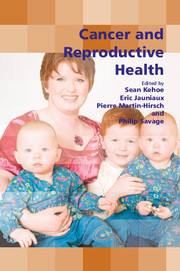Book contents
- Frontmatter
- Contents
- Participants
- Preface
- SECTION 1 Epidemiology, Genetics and Basic Principles of Chemotherapy and Radiotherapy
- SECTION 2 Fertility Issues and Paediatric Cancers
- SECTION 3 Gynaecological Cancers and Precancer
- SECTION 4 Diagnostic Dilemmas
- SECTION 5 The Placenta
- SECTION 6 Non-Gynaecological Cancers
- 18 Pregnancy and breast cancer
- 19 The haematological malignancies
- 20 Melanoma and reproductive health
- SECTION 7 Multidisciplinary Care and Service Provision
- SECTION 8 Consensus Views
- Index
20 - Melanoma and reproductive health
from SECTION 6 - Non-Gynaecological Cancers
Published online by Cambridge University Press: 05 October 2014
- Frontmatter
- Contents
- Participants
- Preface
- SECTION 1 Epidemiology, Genetics and Basic Principles of Chemotherapy and Radiotherapy
- SECTION 2 Fertility Issues and Paediatric Cancers
- SECTION 3 Gynaecological Cancers and Precancer
- SECTION 4 Diagnostic Dilemmas
- SECTION 5 The Placenta
- SECTION 6 Non-Gynaecological Cancers
- 18 Pregnancy and breast cancer
- 19 The haematological malignancies
- 20 Melanoma and reproductive health
- SECTION 7 Multidisciplinary Care and Service Provision
- SECTION 8 Consensus Views
- Index
Summary
Epidemiology
Cutaneous melanoma has increased in incidence progressively in white-skinned populations since the beginning of the 20th century. In the majority of these populations, that increase continues so that in the Yorkshire region in the period between 1 January 1993 and 31 December 2003, the incidence of invasive malignant melanoma increased from 5.4 to 9.7 per 100 000 in men and from 7.5 to 13.1 per 100 000 in women, although fortunately the mortality seems to be levelling off. During the 1990s, incidence rates were by far the highest in northern and western Europe, whereas mortality was higher in males in eastern and southern Europe, and throughout Europe incidence has continued to increase although with some evidence of levelling off in some areas. In western Europe, mortality rates have recently levelled off whereas in eastern and southern Europe both incidence and mortality rates are still increasing.
In much of Europe, the incidence of melanoma is higher in women than it is in men, although in some areas of the world such as Australia the reverse applies. In a recent Yorkshire series, 27% of melanoma cases occurred between the ages of 15 and 44 years, so a significant proportion of melanomas in Europe occur in women in the reproductive age range.
Aetiology
Melanoma is predominantly a cancer of white-skinned peoples, although a rare variety, acral lentiginous melanoma, occurs with a similar incidence in all ethnic groups.
- Type
- Chapter
- Information
- Cancer and Reproductive Health , pp. 257 - 264Publisher: Cambridge University PressPrint publication year: 2008

